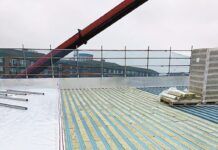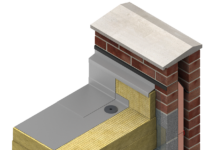 The 600m2 flat roof of the new Pollockshields Health Centre in Glasgow has been securely fixed using SFS intec’s new heat induction welding tool, combined with a chalk marker indication system.
The 600m2 flat roof of the new Pollockshields Health Centre in Glasgow has been securely fixed using SFS intec’s new heat induction welding tool, combined with a chalk marker indication system.
The insulation boards were fixed to the profiled steel deck using SFS intec FI-R thermally broken sleeves, BS-6,1 fasteners and isoweld stress plates. A Sika Trocal waterproof membrane was then applied, with the stress plate positions marked up with chalk before the isoweld stress plates were induction welded to the waterproof membrane.
Alex Owens, operations manager at roofing contractor Procladd, said:
“Using the sophisticated isoweld 3000 system from SFS intec, we had complete confidence that the installation would provide for a secure and straight forward application.
“The security functions built into the machine ensured that welding would only occur when the inductor was over the stress plate, which was located using the search and control function. The tool was liked by the installers as it was ergonomic to use, for example it is fitted wheels for easy site manoeuvrability. The height adjustable handle allowed the installer to stand, which increased efficiency during installation. Calibration was particularly quick and simple to undertake.”
The isoweld 3000’s multiple safety features include automatic adjustments according to the ambient temperature which are integrated into the system, as are compensation factors for current variations. SFS intec says this assists installers in achieving an optimum fixing quality which is virtually independent of the operator or working environment, reducing concerns of human error.
Martyn Holloway, business and development manager at SFS intec, said:
“Mechanical fastening coupled with induction welding, is a strong, safe method for fixing single ply roofs and is unaffected by most of the issues that alternative adhesive fix systems face. Our easy to use isoweld 3000 tool provides a secure and economic fixing solution for the contractor. Additionally, utilising the field fix method of application reduces the number of fasteners necessary by up to 40%, when compared with in-seam fix applications.”




